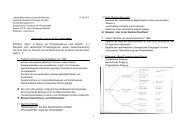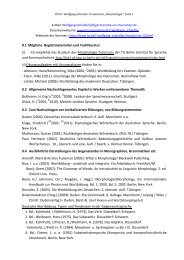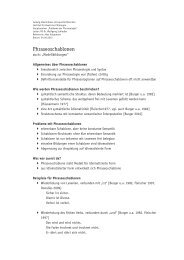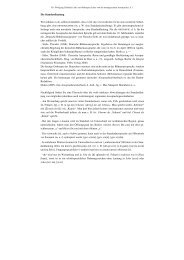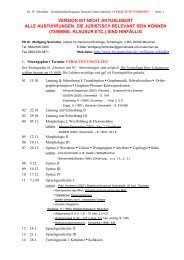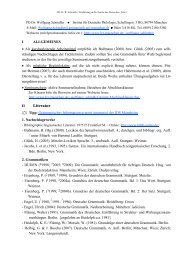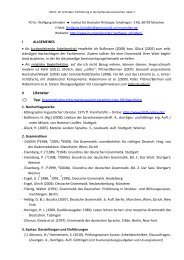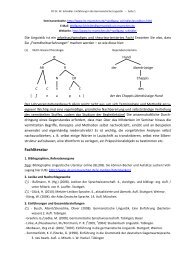Chapter 18 Lexical Functions: Description of Lexical Relations in a ...
Chapter 18 Lexical Functions: Description of Lexical Relations in a ...
Chapter 18 Lexical Functions: Description of Lexical Relations in a ...
Create successful ePaper yourself
Turn your PDF publications into a flip-book with our unique Google optimized e-Paper software.
—<strong>Chapter</strong> <strong>18</strong>. <strong>Lexical</strong> <strong>Functions</strong>— 37<br />
adjective, etc.), provided the mean<strong>in</strong>g <strong>of</strong> L is a functor, i.e., the name <strong>of</strong> an event, process,<br />
relation, property, etc. All structural derivations have their <strong>in</strong>verse functions: if S 0(LV) = L´, then<br />
V 0(L´) = LV, etc.<br />
However, A 0 is an exception <strong>in</strong> this respect: it can apply to the names <strong>of</strong> concrete objects,<br />
and when an A 0 is applied to a concrete noun, it has no <strong>in</strong>verse function, as can be seen from the<br />
example with A 0(city) above.<br />
An overview <strong>of</strong> theoretically possible structural derivations is presented <strong>in</strong> Fig. 2 below.<br />
DER(L)<br />
L<br />
S0 A0 V0 Adv0 S A (honesty) = honest<br />
0 V0(attackN) = attackV Adv (rapidity) = fast<br />
0<br />
A S 0(honest) = honesty V 0(sick) = vomitV Adv 0 (broad) = broadly<br />
V S 0(attackV) = attackN A 0 (vomitV) = sick<br />
Adv S0(fast) = rapidity [room] A0(broadly) = broad V0(fast) = rushV<br />
Figure <strong>18</strong>-1: Theoretically Possible Structural [= DSynt-] Derivations<br />
Adv 0 (rushV) = fast<br />
LFs 11-20 are mean<strong>in</strong>gful derivations <strong>of</strong> L—i.e., LUs which add someth<strong>in</strong>g to<br />
the mean<strong>in</strong>g <strong>of</strong> L. As a rule, the mean<strong>in</strong>g <strong>of</strong> such a derivation <strong>of</strong> L <strong>in</strong>cludes that <strong>of</strong> L:<br />
(DER mean<strong>in</strong>gful (L)) ⊃ (L).<br />
LFs 11-20 are applicable to any L which expresses a functor—that is, denotes a si-<br />
tuation. Among them, LFs 11-16 are actantial and circumstantial nouns. S1 is applicable to LUs<br />
that have at least one Sem-Actant, S 2 to LUs that have at least two SemAs, etc.<br />
11. S i = actantial nouns<br />
The LF S i is the standard name <strong>of</strong> the i-th DSynt-actant <strong>of</strong> L; S i are actantial nouns:<br />
pr<strong>in</strong>cipally, agent noun [(the one who L-s)] and patient noun [(the one whom someone/ someth<strong>in</strong>g<br />
L-s)].<br />
The elements <strong>of</strong> the value <strong>of</strong> an S i(L) are <strong>of</strong> two syntactic types discussed above: fused and<br />
non-fused. A fused element is used <strong>in</strong> the text <strong>in</strong>stead <strong>of</strong> L (especially if this L is a verb); a non-<br />
fused element is used <strong>in</strong> the text together with L, tak<strong>in</strong>g it as its own DSyntA II: S i−II→L.


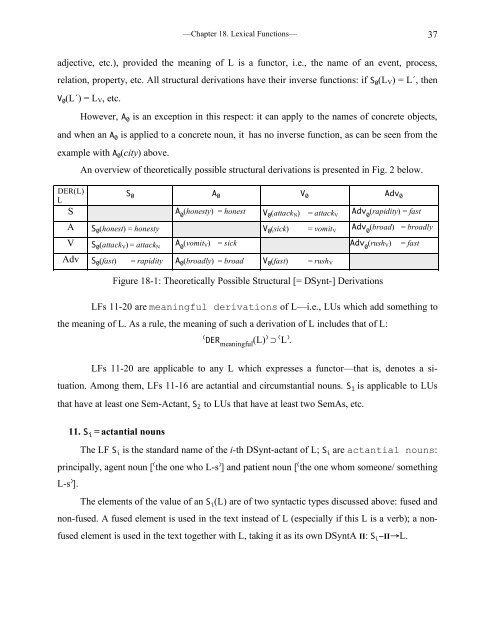
![E-Mail: Wolfgang.Schindler[ätt]germanistik.uni-muenchen.de Web ...](https://img.yumpu.com/51590147/1/184x260/e-mail-wolfgangschindlerattgermanistikuni-muenchende-web-.jpg?quality=85)
